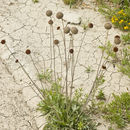Description
provided by eFloras
Perennials (sometimes flowering first year), 20–80 cm. Leaves wholly basal or nearly so; petiolar bases 0–3+ cm; blades spatulate to oblanceolate, 3–10(–15) cm × 5–30(–60) mm, pinnatifid, toothed, or entire, glabrous or very sparsely villous with jointed hairs (obscurely, if at all, gland-dotted). Peduncles 15–75+ cm. Phyllaries 22–32, ovate to lance-attenuate, 6–8 mm, nearly glabrous or villous, or at least ciliate, with jointed hairs. Receptacular setae 0 or 0.1–0.5 mm. Ray florets 0 or 7–10; corollas purplish to red, 10–15 mm. Disc florets 40–100+; corollas pinkish to purplish, tubes 1.2–2 mm, throats urceolate, 3–4 mm, lobes narrowly triangular, 1–1.2 mm, jointed hairs 0.3+ mm (style-branch appendages glabrous or glabrate). Cypselae obpyramidal, 2 mm, hairs 2+ mm, inserted at bases and on angles; pappi of 8–10 lanceolate, oblanceolate, or ovate, aristate scales 6–9 mm (scarious bases 4–5 × 1.4–2 mm). 2n = 38, ca. 72.
- license
- cc-by-nc-sa-3.0
- copyright
- Missouri Botanical Garden, 4344 Shaw Boulevard, St. Louis, MO, 63110 USA
Synonym
provided by eFloras
Agassizia suavis A. Gray & Engelmann, Proc. Amer. Acad. Arts 1: 49. 1847
- license
- cc-by-nc-sa-3.0
- copyright
- Missouri Botanical Garden, 4344 Shaw Boulevard, St. Louis, MO, 63110 USA
Comprehensive Description
provided by North American Flora
Gaillardia suavis (Gray & Engelm.) Britton & Rusby, Trans N. Y. Acad. 7: 11. 1887.
Agassizia suavis Gray & Engelm.; A. Gray, Proc. Am. Acad. 1: 49. 1847. .
Gaillardia simplex Scheele, Linnaea 22: 160. 1849.
? Gaillardia luberculata Scheele, Linnaea 22: 349. 1849.
Gaillardia odorata Lindheimer; A. Grav, Bost. Jour. Nat. Hist. 6: 230. 1850.
Gaillardia trinervata Small, Fl. SE. U. S. 1293. 1903.
A scapose winter annual; leaves basal, somewhat lyrately once or twice pinnatifid or the earliest merely lobed, or spatulate or oblanceolate, triple-ribbed and merely dentate (G. trinervata), 8-15 cm. long, petioled, sparingly hairy on the margins and veins; divisions lanceolate or triangular, acute, often sinuately toothed; scape 2-6 dm. high, striate, more or less hirsute; heads radiate or discoid; bracts oblong, acute, about 1 cm. long, sparingly long-hairy; ray-flowers usually not well developed, either neutral or styliferous but sterile, or wanting; ligules yellow, lilac, or purplish, 1 cm. long or less, 3-cleft, often irregularly so; disk purple, 1.5-2 cm., or in fruit 2-3 cm. broad; corollas about 6 mm. long; tube less than 1 mm. long; throat elongate-campanulate, glabrous; lobes ovate, glandular-pubescent; achenes 3 mm. long, densely hirsute; squamellae ovate-lanceolate, the body about 5 mm. long, produced into, an awn 2-3 mm. long.
Type locality: Plains near Bexar, Texas. Distribution: Oklahoma, Texas, and Coahuila.
- bibliographic citation
- Per Axel Rydberg. 1915. (CARDUALES); CARDUACEAE; HELENIEAE, TAGETEAE. North American flora. vol 34(2). New York Botanical Garden, New York, NY
Gaillardia suavis: Brief Summary
provided by wikipedia EN
Gaillardia suavis is a species of flowering plant in the sunflower family, common names pincushion daisy and perfumeballs. It is native to northern Mexico (Coahuila, Nuevo León, Tamaulipas) and the southern Great Plains of the United States (Kansas, Oklahoma, Texas).
Gaillardia suavis grows in limestone or sandy soils in prairies, desert scrub, or open juniper woodlands. It is a perennial herb up to 80 cm (31 in) tall, with leaves crowded around the base rather than borne on the stem. Each flower head is on its own flower stalk up to 75 cm (30 in) long. Each head generally has 7-10 red or purple ray flowers, though some heads have no ray flowers. The center of the head has 40-100 pink or purple disc flowers.
- license
- cc-by-sa-3.0
- copyright
- Wikipedia authors and editors

